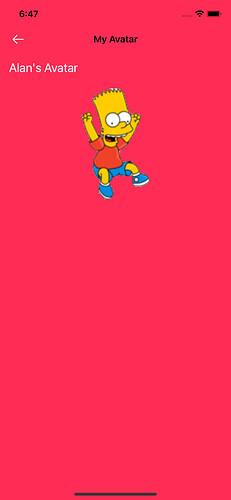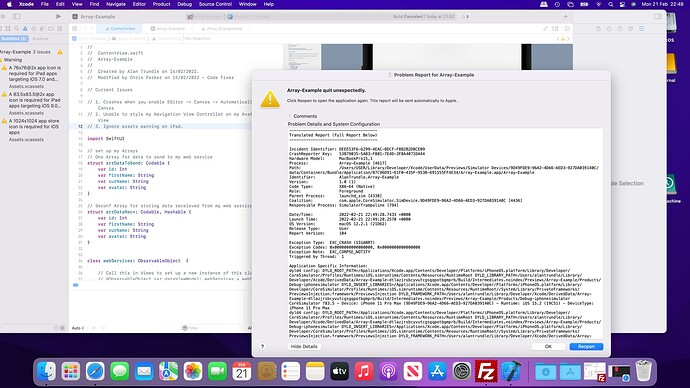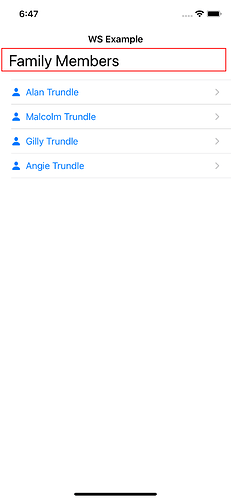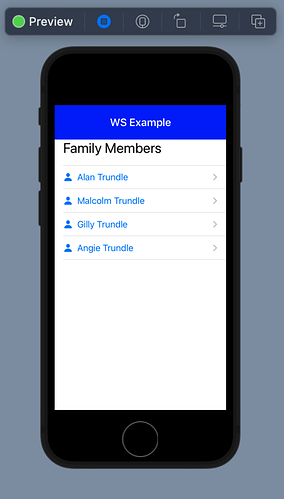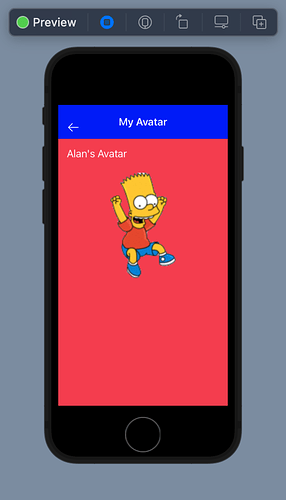Hi Chris,
I spent at least 4 hours today on Google, and saw lots of examples, but like you said you can’t change the NavigationView appearance from other views (child views), or at least I can’t see how to do it.
In Objective C I think you could force redrawing.
So, I am still unable to change the Text foregroundColor, but I did manage from the child view to change the backgroundColor by adding a modifier.
so I went on successfully modifying a class I found to place a “Text” in the middle of the NavigationBar.
Over the top in ZStack.
Sort of works
struct AvatarScreen: View {
let index: Int
@ObservedObject var dataViewModel: webServices = webServices()
@Environment(\.presentationMode) var presentation
let statusBarModifier = NavigationBarModifier(backgroundColor: .blue, navTitle: "My Avatar")
// let statusBarModifier = NavigationBarModifier(backgroundColor: .blue, navTitle: "WS Example")
init(index: Int, dataViewModel: webServices) {
self.index = index
}
var body: some View {
if dataViewModel.myTestArrayRX.firstIndex(where: {$0.id == index}) != nil {
ZStack {
Color.pink
.ignoresSafeArea()
VStack {
HStack {
Text(dataViewModel.myTestArrayRX[index].firstName + "'s Avatar")
.font(.title2)
.foregroundColor(.white)
.padding([.top, .leading, .bottom])
Spacer()
}
AsyncImage(url: URL(string:dataViewModel.myTestArrayRX[index].avatar)) { image in
image
.resizable()
.aspectRatio(contentMode: .fill)
.frame(width:200, height:200)
} placeholder: {
ProgressView()
}
Spacer()
}
//.navigationTitle("My Avatar")
.modifier(statusBarModifier)
.navigationBarBackButtonHidden(true)
.navigationBarItems(leading: Button(action : {
self.presentation.wrappedValue.dismiss()
}){
Image(systemName: "arrow.left")
.foregroundColor(Color.white)
})
}
}
}
}
Here is the class/struct for it :
struct NavigationBarModifier: ViewModifier {
var backgroundColor: UIColor?
var navTitle: String
init( backgroundColor: UIColor?, navTitle: String) {
self.backgroundColor = backgroundColor
self.navTitle = navTitle
// Only works on the root view
let coloredAppearance = UINavigationBarAppearance()
coloredAppearance.configureWithTransparentBackground()
coloredAppearance.backgroundColor = .clear
coloredAppearance.titleTextAttributes = [.foregroundColor: UIColor.white]
coloredAppearance.largeTitleTextAttributes = [.foregroundColor: UIColor.white]
UINavigationBar.appearance().standardAppearance = coloredAppearance
UINavigationBar.appearance().compactAppearance = coloredAppearance
UINavigationBar.appearance().scrollEdgeAppearance = coloredAppearance
UINavigationBar.appearance().tintColor = .white
}
func body(content: Content) -> some View {
ZStack{
//content
VStack {
GeometryReader { geometry in
Color(self.backgroundColor ?? .clear)
.frame(height: geometry.safeAreaInsets.top)
.edgesIgnoringSafeArea(.top)
Spacer()
}
}
// Added this to botch NavigationTitle
VStack {
Text(self.navTitle)
.font(.system(size: 20))
.fontWeight(.semibold)
.foregroundColor(.white)
.padding(20)
.ignoresSafeArea()
.multilineTextAlignment(.center)
Spacer()
}
// now add the content back
content
}
}
}
In the end, I decided to create a style for my Navigation Bar in the view that I created it, and that’s what I am using at the moment.
Doesn’t look like you can change it in the pushed view, but I have seen code that can change It realtime using color control as part of the App.
init()
{
let navBarAppearance = UINavigationBarAppearance()
navBarAppearance.largeTitleTextAttributes = [.foregroundColor: UIColor.white]
navBarAppearance.titleTextAttributes = [.foregroundColor: UIColor.white]
navBarAppearance.backgroundColor = .blue
UINavigationBar.appearance().standardAppearance = navBarAppearance
UINavigationBar.appearance().compactAppearance = navBarAppearance
UINavigationBar.appearance().scrollEdgeAppearance = navBarAppearance
UINavigationBar.appearance().tintColor = UIColor.systemBackground
}
Regards
Alan

